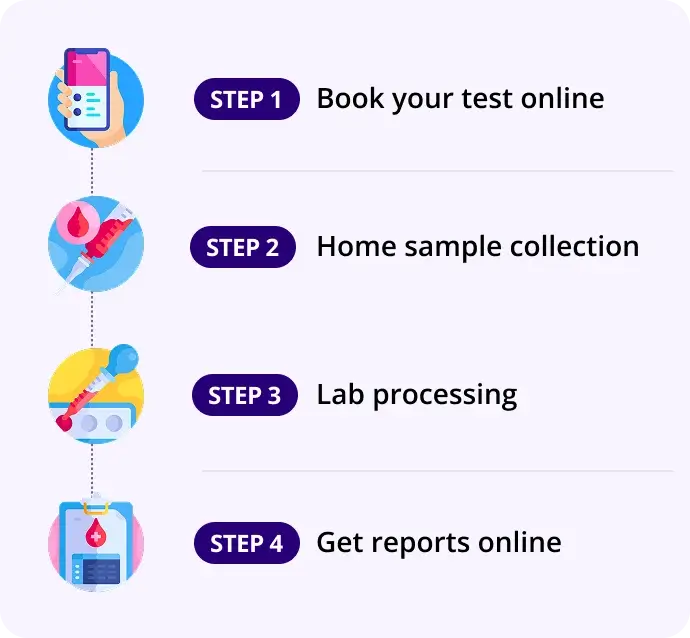AFB-detection by smear examination ZN Stain Urine, 1 samples
Unit Test
Report in 36Hrs
At Home
No Fasting Required
Details
Primarily used to evaluate urinary tuberculosis (genitourinary TB)
₹149₹500
70% OFF
AFB-detection by smear examination ZN Stain Urine 1 samples
- AFB-detection by smear examination ZN Stain Urine 1 samples
- Why is it done?
- Detects acid-fast bacilli (AFB) in urine samples, primarily to diagnose tuberculosis (TB), particularly extrapulmonary TB affecting the urogenital system
- Used to identify Mycobacterium tuberculosis in urine specimens, which indicates renal or urogenital tuberculosis infection
- Typically performed when patients present with symptoms such as dysuria, hematuria, pyuria without bacterial growth, or chronic urinary complaints suggestive of TB
- Essential in TB surveillance and diagnosis programs as part of diagnostic confirmation and treatment monitoring protocols
- Recommended for patients with known pulmonary TB to rule out disseminated disease, and for suspected cases of genitourinary TB
- Normal Range
- Negative Result: Reported as 'AFB Not Seen' or 'Negative for AFB' - indicates absence of acid-fast bacilli in the urine specimen
- Positive Result: Reported as 'AFB Seen' or 'Positive for AFB' - indicates presence of acid-fast bacilli, consistent with mycobacterial infection
- Quantification: Positive results may be graded as 1+, 2+, 3+, or scanty based on the number of AFB observed per microscopic field
- Units: Qualitative assessment per microscopic field under Ziehl-Neelsen staining
- Interpretation
- Negative AFB Smear: Suggests absence of mycobacterial infection in the urinary tract. However, a single negative result does not completely rule out TB, as AFB may not be present in all specimens from infected individuals.
- Positive AFB Smear (Scanty/1+): Indicates low bacillary load; highly suggestive of mycobacterial infection. Further confirmation with culture or PCR recommended.
- Positive AFB Smear (2+/3+): Indicates moderate to high bacillary load, strongly confirmatory for active mycobacterial infection. Patient is typically considered infectious.
- Factors Affecting Results: Sample collection timing (morning urine preferred as it is more concentrated), adequate sample volume (24-hour collection may increase sensitivity), specimen handling, and patient immune status
- Clinical Significance: Positive results confirm genitourinary TB diagnosis. Smear positivity correlates with infectiousness and treatment responsiveness, making it crucial for public health monitoring.
- Associated Organs
- Primary Organ Systems: Urinary system (kidneys, ureters, bladder, urethra) and reproductive system (prostate, seminal vesicles, fallopian tubes, ovaries)
- Diseases Associated with Abnormal Results: Renal tuberculosis (most common), ureteral TB, bladder TB, prostate TB, epididymitis TB, female genital TB (tuberculosis endometritis, salpingitis)
- Complications and Risks: Renal scarring and fibrosis, chronic kidney disease, ureteric strictures, bladder contracture, infertility, sepsis, disseminated TB if untreated
- Related Pathophysiology: Mycobacterium tuberculosis reaches the urinary tract through hematogenous dissemination from primary TB focus, causing granulomatous inflammation and tissue destruction
- Follow-up Tests
- Culture and Sensitivity: Gold standard for TB diagnosis; urine cultures on Lowenstein-Jensen or MGIT media for definitive identification and drug susceptibility testing
- GeneXpert MTB/RIF (Xpert MTB/RIF): WHO-endorsed rapid molecular test for TB diagnosis and rifampicin resistance detection on urine samples
- PCR Testing: Polymerase chain reaction for MTB DNA amplification; high sensitivity and specificity for confirming TB infection
- Imaging Studies: CT scan or ultrasound of abdomen/pelvis to assess extent of renal and urogenital TB damage and guide treatment
- Urinalysis: Complete urinalysis to assess pyuria, hematuria, and other abnormalities; sterile pyuria is typical of renal TB
- Renal Function Tests: Creatinine, BUN, and eGFR to monitor kidney function; repeated at baseline and during treatment
- Chest X-Ray: To detect concurrent pulmonary TB; genitourinary TB often occurs with pulmonary involvement
- Monitoring During Treatment: Repeat AFB smear examination monthly during first 2 months, then bimonthly; should show decreasing AFB grades with effective treatment
- Fasting Required?
- Fasting: No - Fasting is NOT required for this test
- Sample Collection Instructions: Morning urine specimen preferred (early morning first void) as it is more concentrated and has higher yield of AFB. Collect 24-hour or early morning urine sample as per laboratory protocol.
- Special Preparation: No special fasting or dietary restrictions. Patient may eat and drink normally. Ensure proper genital/perineal hygiene before sample collection to avoid contamination.
- Medications: Continue all regular medications as scheduled. No specific medications need to be withheld for this test.
- Sample Handling: Use sterile, wide-mouthed container. Process samples within 2-4 hours of collection for optimal sensitivity. Refrigerate if delayed processing is anticipated.
- Timing of Test: Can be performed at any time of day, but morning urine is preferred. Multiple samples on consecutive days may increase diagnostic sensitivity.
- Why is it done?
How our test process works!

